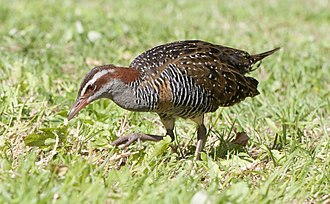Gruiformes
Gruiformes is an order of birds that comprises a diverse group of families, known for their varied sizes, habitats, and diets. The order includes several well-known birds such as cranes, rails, and moorhens. Gruiformes are found worldwide, from tropical rainforests to arid deserts, showcasing their adaptability to different environments.
Characteristics
Birds within the Gruiformes order exhibit a wide range of sizes, body shapes, and feather colors, making the order one of the most diverse in the avian world. However, many gruiform birds share common characteristics such as long legs and toes, which are well adapted for wading through water or walking on soft ground. Their beaks also vary in shape and size, adapted to their specific diets, which can range from plants and seeds to small animals and insects.
Habitat and Distribution
Gruiformes are found in a variety of habitats across the globe. Many species prefer wetlands, marshes, or riverbanks, where they can forage for food in the mud or shallow water. Others inhabit forests, grasslands, or arid regions. Their wide distribution reflects the adaptability of gruiform birds to different environmental conditions.
Families
The order Gruiformes includes several families, some of the most notable being:
- Rallidae: This family includes rails, crakes, coots, and moorhens. Members of this family are known for their secretive behavior, often hiding in dense vegetation near water. - Gruidae: The crane family, characterized by their tall stature, long necks, and legs. Cranes are known for their elaborate mating dances and calls. - Heliornithidae: Also known as finfoots, these birds are adapted to an aquatic lifestyle, with lobed feet for swimming. - Aramidae: This family is represented by a single species, the Limpkin, which resembles a large rail and is found in the Americas.
Conservation
Many Gruiformes species face threats from habitat loss, pollution, and hunting. Wetland drainage and the conversion of land for agriculture and urban development have significantly reduced the available habitat for these birds. Conservation efforts are underway in many parts of the world to protect the remaining habitats and the species that rely on them.
Evolution and Systematics
The evolutionary history of Gruiformes is complex, with molecular studies suggesting that the order is not as closely related as once thought, leading to debates about the classification and relationships among the families within the order. Some families traditionally placed in Gruiformes have been moved to other orders based on genetic evidence.
In Culture
Gruiformes, especially cranes, have been symbols of luck, longevity, and fidelity in various cultures around the world. Their presence in art, folklore, and literature underscores the deep connection humans have with these birds.
This avian-related article is a stub. You can help WikiMD by expanding it.
Transform your life with W8MD's budget GLP-1 injections from $125.
W8MD offers a medical weight loss program to lose weight in Philadelphia. Our physician-supervised medical weight loss provides:
- Most insurances accepted or discounted self-pay rates. We will obtain insurance prior authorizations if needed.
- Generic GLP1 weight loss injections from $125 for the starting dose.
- Also offer prescription weight loss medications including Phentermine, Qsymia, Diethylpropion, Contrave etc.
NYC weight loss doctor appointments
Start your NYC weight loss journey today at our NYC medical weight loss and Philadelphia medical weight loss clinics.
- Call 718-946-5500 to lose weight in NYC or for medical weight loss in Philadelphia 215-676-2334.
- Tags:NYC medical weight loss, Philadelphia lose weight Zepbound NYC, Budget GLP1 weight loss injections, Wegovy Philadelphia, Wegovy NYC, Philadelphia medical weight loss, Brookly weight loss and Wegovy NYC
|
WikiMD's Wellness Encyclopedia |
| Let Food Be Thy Medicine Medicine Thy Food - Hippocrates |
Medical Disclaimer: WikiMD is not a substitute for professional medical advice. The information on WikiMD is provided as an information resource only, may be incorrect, outdated or misleading, and is not to be used or relied on for any diagnostic or treatment purposes. Please consult your health care provider before making any healthcare decisions or for guidance about a specific medical condition. WikiMD expressly disclaims responsibility, and shall have no liability, for any damages, loss, injury, or liability whatsoever suffered as a result of your reliance on the information contained in this site. By visiting this site you agree to the foregoing terms and conditions, which may from time to time be changed or supplemented by WikiMD. If you do not agree to the foregoing terms and conditions, you should not enter or use this site. See full disclaimer.
Credits:Most images are courtesy of Wikimedia commons, and templates, categories Wikipedia, licensed under CC BY SA or similar.
Contributors: Prab R. Tumpati, MD

